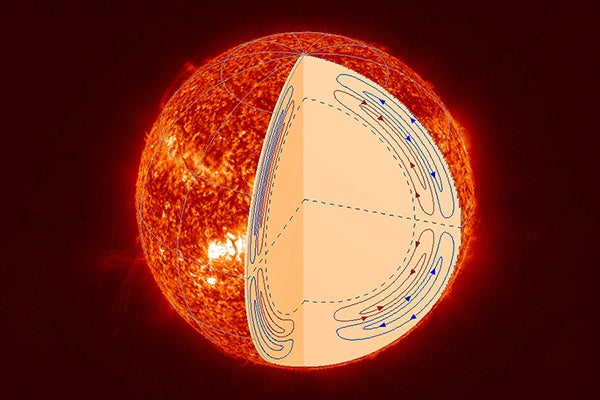|
August 28, 2013
Stanford solar scientists solve one of the sun's mysteries
The sun's magnetic field can play havoc with communications technology. Stanford scientists have now described one of the underlying processes that help form the magnetic field, which could help scientists predict its behavior. By Bjorn Carey

The sun's double-cell meridional circulation structure is shown as streamlines in this diagram based on research at Stanford's Hansen Experimental Physics Laboratory. (NASA SDO/HMI)
Stanford solar scientists have solved one of the few remaining fundamental mysteries of how the sun works.
The mechanism, known as meridional flow, works something like a conveyor belt. Magnetic plasma migrates north to south on the sun's surface, from the equator to the poles, and then cycles into the sun's interior on its way back to the equator.
The rate and depth beneath the surface of the sun at which this process occurs is critical for predicting the sun's magnetic and flare activity, but has remained largely unknown until now.
The solar scientists used the Stanford-operated Helioseismic and Magnetic Imager (HMI) – an instrument onboard NASA's Solar Dynamic Observatory satellite – to track solar waves in much the way seismologists would study seismic movements beneath the surface of the Earth. Every 45 seconds for the past two years, the HMI's Doppler radar snapped images of plasma waves moving across the sun's surface.
By identifying patterns of sets of waves, the scientists could recognize how the solar materials move from the sun's equator toward the poles, and how they return to the equator through the sun's interior.
"Once we understood how long it takes the wave to pass across the exterior, we determined how fast it moves inside, and thus how deep it goes," said Junwei Zhao, a senior research scientist at the Hansen Experimental Physics Laboratory at Stanford, and lead author on the paper.
Although solar physicists have long hypothesized such a mechanism, at least in general terms, the new observations redefine solar currents in a few ways. First, the returning currents occur 100,000 kilometers below the surface of the sun, roughly half as deep as suspected. As such, solar materials pass through the interior and return to the equator more quickly than hypothesized.
More startling, Zhao said, is that the equator-ward flow is actually sandwiched between two "layers" of pole-ward currents, a more complicated mechanism than previously thought, and one that could help refine predictions of the sun's activity.
"Considered together, this means that our previously held beliefs about the solar cycle are not totally accurate, and that we may need to make accommodations," Zhao said.
For example, some computer models projected that the current solar cycle would be strong, but observations have since showed it is actually much weaker than the previous cycle. This inconsistency could be due to the previously unknown inaccuracies of the meridional circulation mechanism used in the simulations.
Improving the accuracy of simulations, Zhao said, will produce a better picture of fluctuations of the sun's magnetic field, which can interfere with satellites and communications technology on Earth. The sun's magnetic field resets every 11 years – the next reset will occur sometime in the next few months – and there is evidence that changes in the meridional flow can influence how the magnetic field evolves during a particular cycle.
"We want to continue monitoring variations of the meridional flow," he said, "so that we can better predict the next solar cycle, when it will come and how active it will be."
The report was published in the online edition of The Astrophysical Journal Letters. It was co-authored by three other researchers at the Hansen Experimental Physics Laboratory – senior scientists Rick Bogart and Alexander Kosovichev and research associate Thomas Hartlep – as well as NASA senior scientist Tom Duvall. Phil Scherrer, a professor of physics at Stanford, is the principal investigator of the HMI project and supervised the study.
For more Stanford experts on physics and other topics, visit Stanford Experts
-30-
|